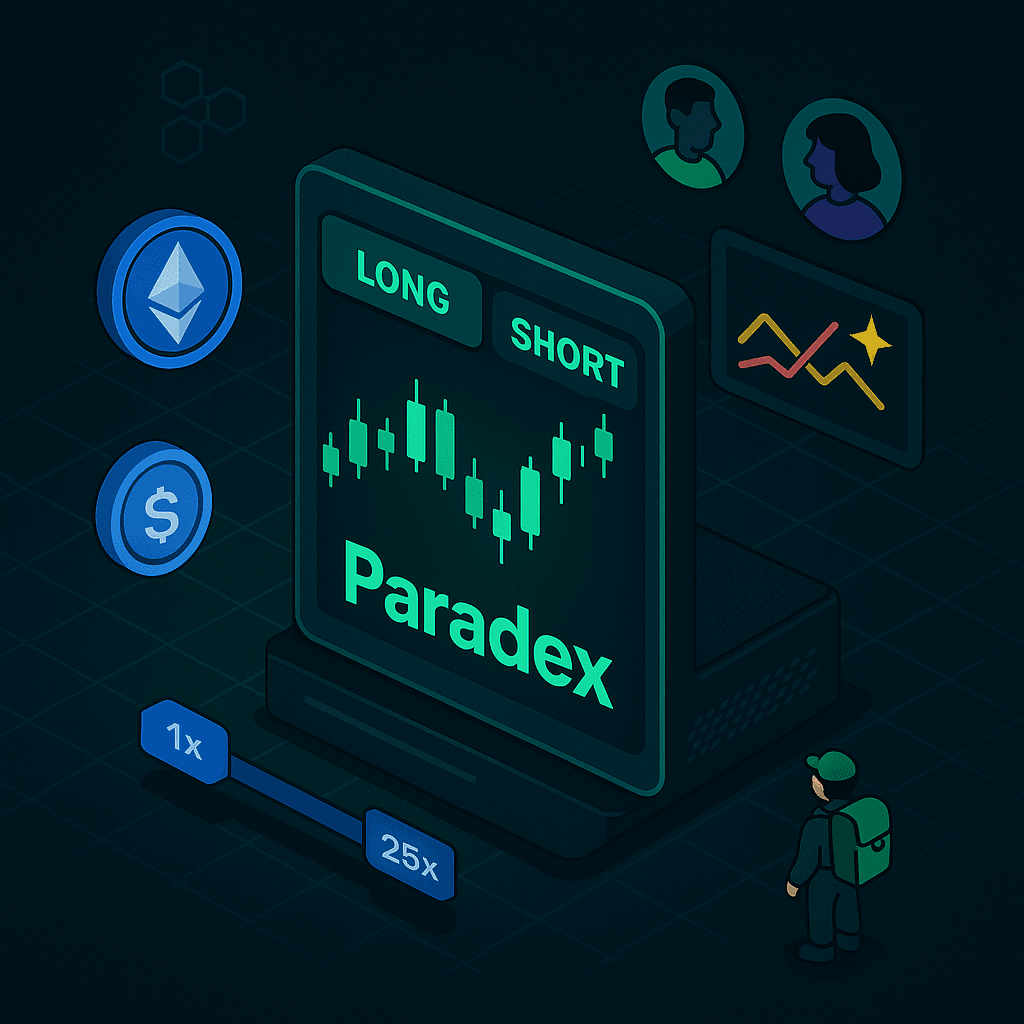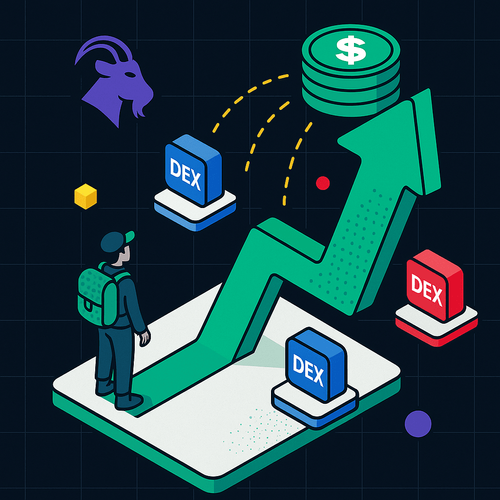Introduction
We have previously covered Paradex here at Nansen, and since then a there has been a few developments, namely the introduction of perpetual options and updated tokenomics that introduce among others, performance-based vesting for the team. In this piece, we delve into the structure and mechanics of Paradex’s perpetual options – including their settlement model, collateralization framework, liquidity considerations, and how they differ from conventional perpetuals – and then analyze the updated DIME tokenomics, particularly the changes to Paradigm’s shareholder unlocks and the team’s performance-based vesting.
Paradex Perpetual Options: What You Need to Know
Paradex’s perpetual options are a fresh take on crypto derivatives. They work like traditional options (asymmetric payoff, downside protection) but never expire – meaning no rolling, no expiry stress, and more capital-efficient trading.
What Makes Them “Perpetual”?
Instead of paying a one-time premium, you pay ongoing funding (like a daily fee) to hold your position. You can hold it as long as you want, or close out anytime. No expiry = no time decay crush near expiry. If you're bullish, for example, buy a call and wait — you're only on the hook for the funding while you hold.
Key Features
- No Liquidations (for Buyers): Longs can’t be liquidated by price swings — your max loss is what you pay over time.
- Unlimited Upside: Like a regular call option, you benefit from large moves.
- High Effective Leverage: Since the upfront cost is low, you can control large notional exposure (50x+ on far OTM options).
- Simple PnL Like Perps: Your profit/loss is mark-to-market — entry price, exit price, and funding paid — similar to perps.
Perpetual Options vs. Perpetual Futures
| Feature | Perpetual Options | Perpetual Futures |
|---|---|---|
| Payoff Structure | Non Linear and Asymmetric(Accelerated Upside + Limited Downside) | Linear and Symmetric (unlimited upside and downside) |
| Leverage | Variable leverage based on option delta | Fixed leverage based on margin |
| Funding | Includes cost of leverage plus insurance | Only reflects cost of leverage |
| Liquidation Risk | Lower liquidation risk (for buyers) | Higher liquidation risk |
| Capital Efficiency | May require less capital for similar exposure | Requires more capital to avoid liquidation |
If you’ve used 10x futures and got wiped before the market turned in your favor, this solves that problem. You can ride the trade as long as you can afford the funding.
Perpetual Options vs. Dated Options
| Feature | Perpetual Options | Dated Options |
|---|---|---|
| Expiration | Never expire | Expire at a specific date and time |
| Time Decay | No time decay (theta) | Value decreases as expiration approaches |
| Premium Payment | Paid continuously through funding | Paid upfront as a lump sum |
| Liquidity | Concentrated in fewer instruments | Fragmented across strikes and expiries |
| Behavior | Like a rolling 24-hour option | Fixed time horizon |
| Risk Management | No expiry mismatch with perps | Require active management of expiry |
Risk and Margin
For longs, risk is the funding you keep paying. No expiry, no liquidation — just ongoing cost. For shorts, margin is more complex, since risk is theoretically larger. Paradex uses dynamic rules (based on how in-the-money the option is) to size margin fairly.
They're also building portfolio margining, so you can offset an option with a futures hedge — making strategies like covered calls or volatility plays much more efficient.
Liquidity and Institutional Edge
While Paradex is newer, it has a strong backer, Paradigm, and it’s integrating with block RFQ networks for large trades — letting HNW users tap into deeper liquidity off-chain. It also avoids liquidity fragmentation by keeping one continuous market per strike, instead of multiple expiries.
Who Is This For?
Perfect for traders who:
- Want leveraged exposure with capped downside.
- Trade volatility (long or short).
- Hate managing expiries.
- Run basis or hedging strategies using both perps and options.
Paradex’s design unlocks more advanced, flexible strategies on-chain — and if liquidity scales, it could challenge centralized venues or generally venues to which previously only HNW clients had access.
A Look at Paradex’s Revamped Tokenomics
Two big changes stand out: staggered unlocks for Paradigm stakeholders and performance-based vesting for the team. Both aim to reduce early sell pressure and reward execution, not just tenure.
No More Instant Unlocks for Paradigm Investors
Originally, Paradigm shareholders (who were allocated 13.4% of DIME) were going to have their full stake unlocked at launch. That raised eyebrows — a huge chunk of supply unlocked on day one is risky.
The fix: Paradex rolled out a staggered unlock schedule:
- Tokens will now vest in stages.
- Legal contracts explicitly prevent any early sell-offs — no offloading via derivatives, lending, or OTC deals.
This reduces potential sell pressure and signals serious long-term alignment. For HNW investors, it means early insiders can’t quietly exit — they’re in it for the ride.
Team Tokens Tied to Performance, Not Just Time
In a move that breaks from crypto norms, Paradex made 80% of the core team’s tokens performance-based. Only 20% vest over time.
How it works:
- The team must hit defined milestones (e.g., user growth, trading volume, tech launches).
- Milestones are grouped by epochs (e.g., Year 1 goals).
- Even when goals are hit, tokens still vest over four years — no quick cash-outs.
This dual lock (performance + time) prevents the typical "launch and leave" problem. It’s also investor-friendly: tokens only hit the market if the platform is actually delivering.
Even Paradex’s early equity holders (not just employees) are held to the same standard — their tokens unlock only with results.
Why This Matters for Investors
- Reduced sell pressure at launch. Paradigm tokens are drip-fed into the market.
- Team must earn their upside. No dilution unless real value is created.
- Better transparency. Paradex will publish the milestone criteria before DIME launches.
It’s designed to protect community value, ensure insider alignment, and promote sustainable growth.
Conclusion
Paradex continues to evolve in ways that suggest a thoughtful, long-term approach to both product design and ecosystem incentives. Its perpetual options are a creative twist on familiar instruments, offering traders more flexibility without sacrificing risk control. On the tokenomics side, the updated unlock schedules and performance-based vesting mechanics reflect a clear intent to align core stakeholders with the broader community, a welcome shift in a space often criticized for short-termism.
I've been exploring Paradex for some time, and the perpetual trading functionality is already well-developed. With the addition of perpetual options an area that could become a significant revenue driver for the platform it's a interesting new idea for the space perps trading space. For those considering eligibility for a potential airdrop, engaging with Paradex might be worth considering.
For investors, especially those taking a longer view, these developments are encouraging. There is still some anticipation around how the performance milestones will be defined, and rightly so — getting that balance right between ambition and realism will be key. But so far, the direction feels measured and investor-conscious. We’ll be watching with interest to see how it plays out.




